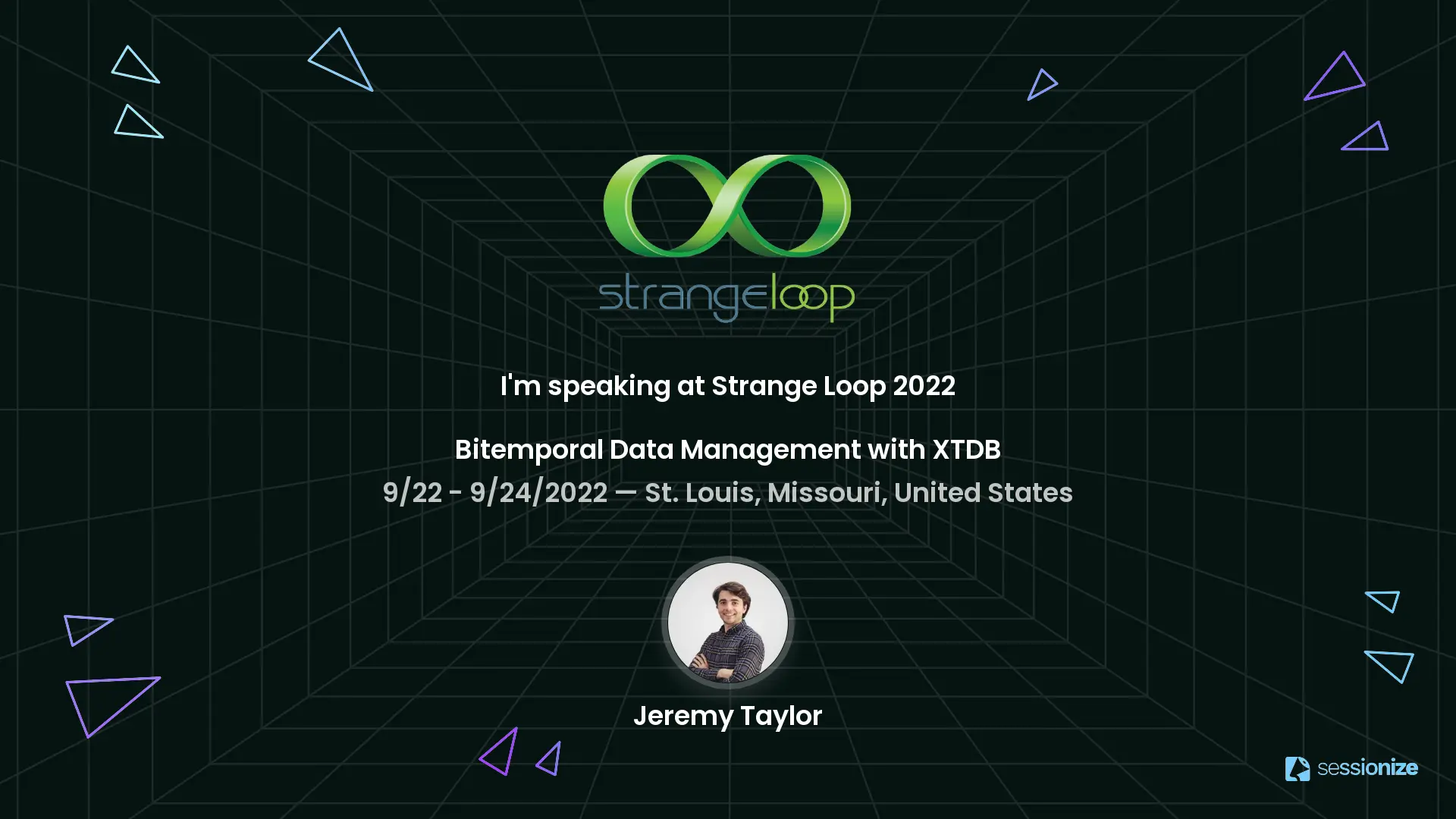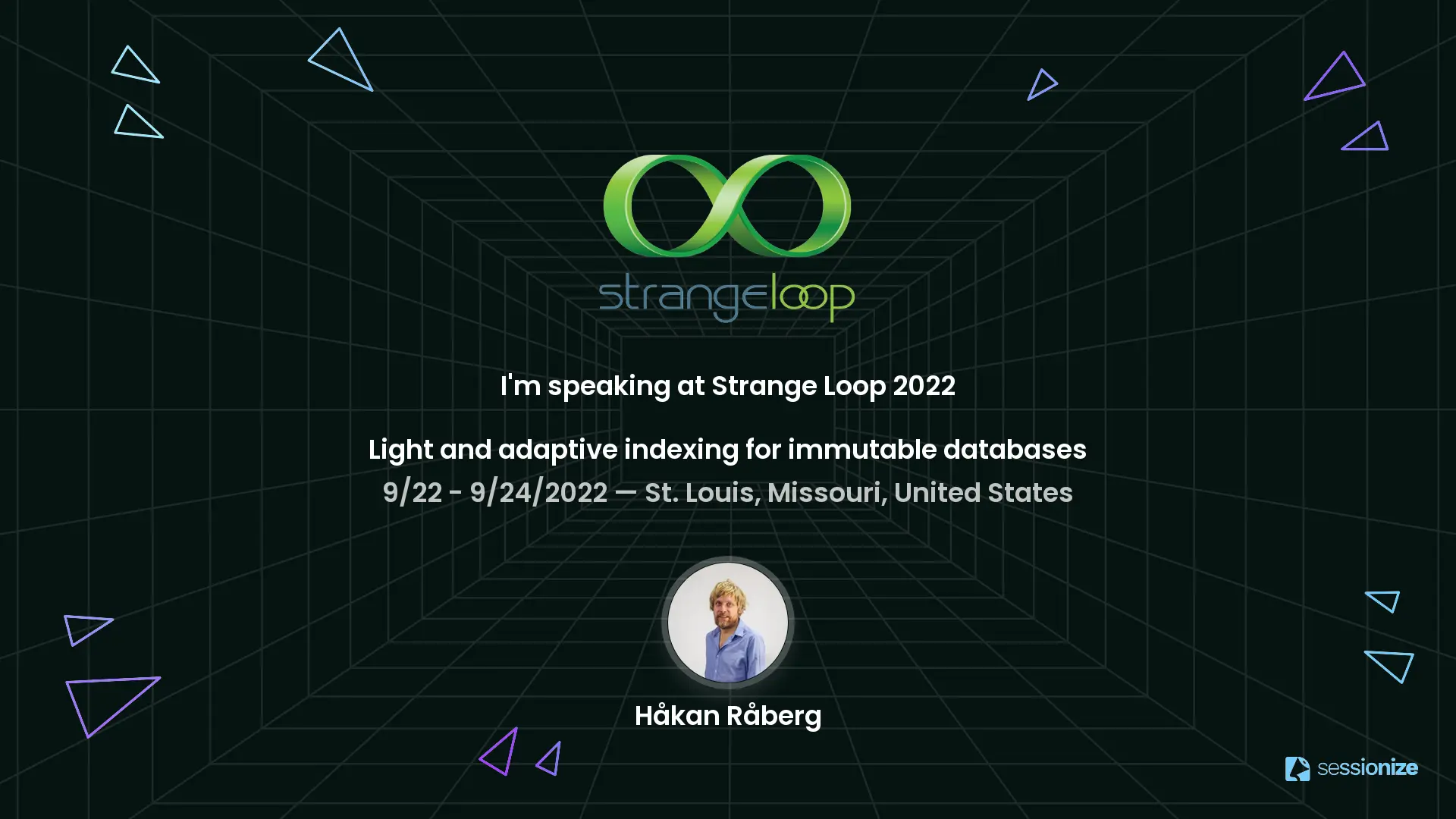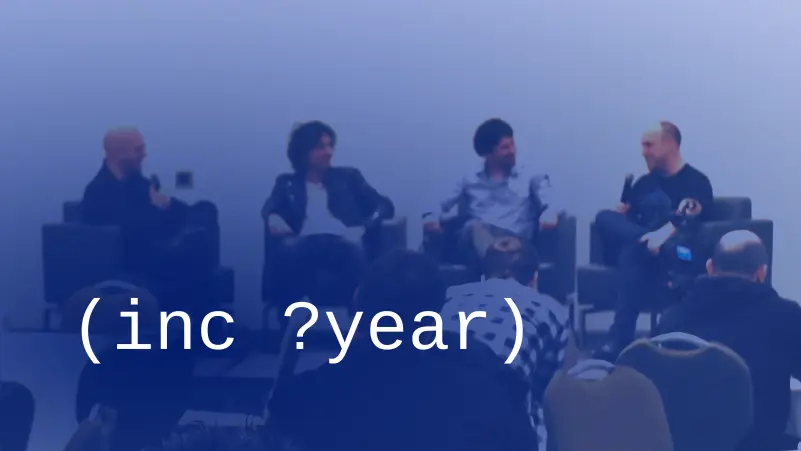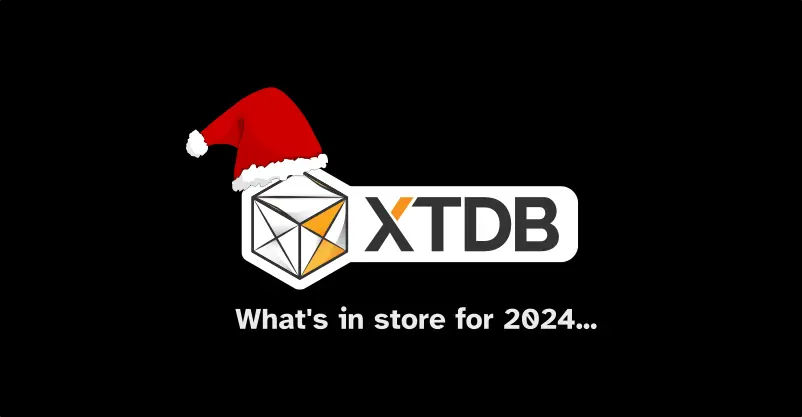Friday, 27 May, 2022
Development Diary #7
 Jeremy Taylor
Jeremy Taylor Welcome to the seventh edition of the XTDB Dev Diary. Our work over the past six months has been divided across quite a few distinct tracks — some visible, others less so. We’re looking forward to catching you up! Details about our upcoming exposition at Strange Loop in September are below also.
Changelog: 1.18, 1.19, 1.20, 1.21
Much of our effort in late 2021 was spent hardening XTDB. As more and more companies are deploying XTDB into production, we’ve been given an increasing number of opportunities to squash edge-case bugs and solidify XTDB’s behaviours.
1.18.1 predominantly brought Lucene improvements.
We added a :refresh-frequency parameter, similar to Elastic’s refresh_interval setting, and improved Lucene’s performance.
We also improved custom indexes by including the original transaction operations in the callback.
1.19.0 was, in some ways, our biggest release yet (in terms of raw lines of code!) — we renamed the database to XTDB. We’ll speak about this more in its own section.
1.20.0 was an hardening release purely for Lucene’s benefit, ensuring that it can cope with absent documents and be restored from a checkpoint. We also changed the pull behaviour to return nil on empty joins.
1.21.0 was a much bigger hardening release with a few long-awaited new features.
TPC-H performance improved, caches were stabilized with better hash distribution, Clojure was bumped to 1.11, many small edge case errors were corrected, and a number of behaviours were made more consistent: pull-many, failed match, Lucene :timeout, auto-incrementing identifiers in Postgres and MySQL, and more.
In 1.21.0, three big new features landed.
First, :find clauses now support simple Clojure expressions in projections and aggregations.
Second, you can now import Transaction Time from an upstream source — a huge win for temporal power users.
Last, but certainly not least, users on Apple M1 chips now have fast, native ARM build support for RocksDB.
New name, new website
XTDB hasn’t always been XTDB. Most of our users remember a time when it was a little database lovingly known as Crux. Crux grew out of a very real bitemporal data processing problem which surfaced in a JUXT project for a Tier-1 bank. The vision and technical scope of XTDB has continued to evolve ever since, and in the meantime performance has improved and APIs have stabilized.
By the time XTDB found its final name, it was already a very solid product used in many organizations — most of which we don’t know! Unless someone has a commercial contract with us, or reaches out to us via Discuss / Twitter / etc, we’re none the wiser. The beauty of open source.
XTDB isn’t just a new name, though. With it comes quite a grand vision for the future. We feel — now more than ever — that immutability and time play a fundamental role in every system we have ever built, repaired, or maintained. XTDB is a fun play on the JUXT logo, but we’re also quite serious when we describe it as the "Cross Time Database".
XTDB in the wild
XTDB originated from the domain of End-of-Day Risk calculations, so it’s no surprise that we hear about users applying it to financial systems quite frequently. Trading firms are using XTDB as a "tactical bitemporal database" across a variety of grey box trading, instrument, and analytical services. Quant firms are using XTDB as an HTAP database for algo research. Big banks use XTDB for risk, auditing, and compliance.
But we’re surprised every week by the industries putting XTDB into production. In the education sector, it’s used to track teachers and class loads. In workforce management, it’s used as a flexible graph database that allows users to model data themselves. The list goes on.
Many of these companies are household names. Unfortunately, just as we hand-wave over "Tier-1 banks", we are often forced to hand-wave over these logos. Over the coming year, as more companies sign up for our Partner Program and Commercial Support, we look forward to sharing their stories with you.
Have You Tried Rubbing A Database On It?
HYTRADBOI was an information-packed virtual conference at the end of April. It consisted of 10-minute pre-recorded talks woven together using only open source technologies. The conference was held on a self-hosted Matrix server and the afterparty was hosted on Jitsi. I was fortunate enough to give a talk: Baking in time at the bottom of the database, a technical background and justification for our creation of XTDB.
It was a great opportunity to hear about Martin Kleppmann’s latest work on CRDTs and I thought the Ultorg demo was particularly impressive. Huge thanks to Jamie Brandon for putting on the event!
If you enjoyed that talk, I encourage you to come to my workshop in September at Strange Loop 2022! I’ll be taking participants through real-world bitemporal data challenges with and without XTDB.
Market Research
From the moment we started pursuing XTDB as a commercial product, the team has spent hundreds of hours interviewing users, partners, customers, and advisors. We’ve asked everyone to look at XTDB, retrospectively, and tell us their honest opinion about data problems their company faces. The results are consistent.
First, no one wants to babysit a database in 2022.
A large part of XTDB’s current appeal is how fast and easy it is to get started: add a dependency on com.xtdb/xtdb-core and start adding data.
Bam, done.
Everyone we spoke to wants this level of operational simplicity — but across all languages and platforms.
The second problem everyone wants solved is equally unsurprising: easy, immutable data.
Whether your business thinks of it as "lineage", "provenance", or "perfect audits", absolutely everyone is tired of working around mutable databases (AKA "the queryable cache") with event sourcing.
Event sourcing should be for, well, events — not a bandaid on the fact that almost every major database throws out data with each UPDATE operation (or makes the old record unqueryable).
From there, everyone has an itch to scratch. CTOs are very interested in solving the "two database problem" with Hybrid Transactional-Analytical Processing (HTAP), and they don’t want to maintain an ETL (or ELT) pipeline anymore. Developers want real time-traveling queries and versioning for free in their OLTP systems, they don’t want to shoehorn their realtime data into an OLAP system anymore. The DDD folks want nested records, they don’t want to cram strings into Postgres JSON columns anymore. Data scientists want first-class SQL, they don’t want to learn a new query language.
We’ve been listening.
Behind The Scenes
…but we haven’t only been listening. We’ve also been researching and building. It’s our goal to take what everyone currently loves about XTDB (in the words of Jacob O’Bryant, "the database that sparks joy") and grow it. Much of that growth is interlinked. We think of these interlinked qualities as the pillars of XTDB.
Pillar #1: SoSaC
If we hope to build the world’s most-loved immutable database, it has to do immutability very well, and we firmly believe that "doing immutability well" implies the Separation of Storage and Compute (we recently recorded a podcast episode all about this concept — see below). However currently, as of 1.21.0, XTDB’s operational storage layer (a.k.a. the Index Store) requires the underlying Key-Value store (e.g. RocksDB) to exist on every node with a full replica of almost all data. In the future, XTDB will reorient around cloud object storage and handling data in large columnar 'chunks', to allow nodes to retrieve and process on-demand only the subset of chunks needed for a given set of queries. This will enable much simpler and more cost-effective horizontal scaling.
Pillar #2: Columnar HTAP
XTDB 1.21.0 is an aspiring HTAP database; it can already execute complex point-in-time temporal queries and graph queries that most of the old guard would struggle with. However, if users really want XTDB to service a more widespread proportion of their OLTP and OLAP workloads, we know that a reorganization of the core machinery is necessary. To that end, we have been building a new columnar storage engine based on top of Apache Arrow.
Pillar #3: Temporal Indexing
XTDB 1.21.0 already uses multiple clever techniques to maintain temporal indexes. These were specifically designed to enable efficient point-in-time bitemporal queries. However, practically every week we see new bitemporal modeling use cases and requirements discussed in popular forums — it seems many developers don’t even realize they have a bitemporal problem until they’re neck deep. Luckily there is decades' worth of research on bitemporal data management to mine for inspiration on what lies beyond the point-in-time query model; we’ve done that. Armed with what we’ve learned, we’re building a much more powerful temporal index.
Pillar #4: Dynamism
XTDB 1.21.0 allows almost any data to be stored including deeply nested documents with arbitrary java.io.Serializable types (thanks to Nippy!), however, sargable (index-backed) querying is restricted to top-level values.
Looking ahead, Apache Arrow data types are more restrictive — in a way we consider hygienic, not detrimental — and also enable us to pursue a database which is more flexible and dynamic.
We hope to make nested data both easy to insert and also easy to query.
As James puts it: "Just put maps. Just query maps. That’s it."
Pillar #5: "Easy to use"
We need to make XTDB as easy to use for Elixir and Python users as it currently is for Clojure (and other JVM) users. Doing so has a few implications.
First, and most difficult, is making SQL a first-class citizen of XTDB. At JUXT, we absolutely love Datalog — but we’re Clojure developers. We have routinely heard that "there’s just no escaping SQL" and we believe it. We aren’t just building XTDB for ourselves. We are well underway in replacing XTDB’s current SQL module built on Apache Calcite with a native implementation of the SQL standard (including SQL:2011 bitemporal operators!).
The second implication is that we will need to build first-class client libraries for all major programming languages. As far as SQL is concerned, this predominantly means JDBC, ODBC, and native drivers.
If client libraries and drivers are the user interface, the other side of the "ease of use" coin is operational complexity. XTDB is already quite easy to use, but we intend to automate and simplify everything we can. We have also considered providing XTDB as a service ("XTaaS"?). If this interests you, we would love to know what your requirements of such a service would be: hello@xtdb.com
Open Source
These research initiatives are under heavy development internally. As the xtdb.com homepage states, our ethos is "Fully Open Source" — and this still holds. But we do not want to confuse or frighten anyone by waving around a bunch of experimental code prematurely. We will continue to harden XTDB just as we did throughout 2021: with incremental stable releases and long-term support for all our users.
We are eager to share exciting new source code with you though — and we will as soon as we move out of "experimental" territory.
The Future of XTDB at Strange Loop 2022
Community
Here are some cool things users have been sharing recently:
-
py xtdb — a tiny library to interact with XTDB via Python’s Requests module (see the Zulip thread)
-
pharo-XTDB — XTDB client for Pharo Smalltalk
-
XTDB Chinook + Clojure datafy/nav demo sample projects
XTDB wouldn’t exist without its high-energy community. Thank you to everyone who shares in XTDB-related excitement with us across the globe. We can’t wait to share the updates of the coming months!
As always, do get in touch with the team if you have any questions, issues, or feedback.
-
Discuss (forums)




